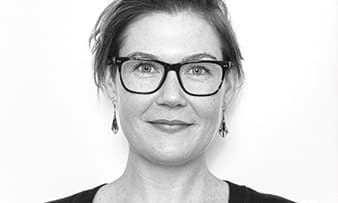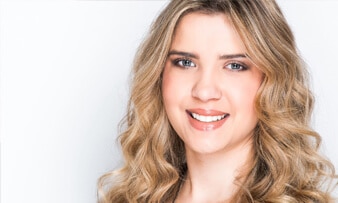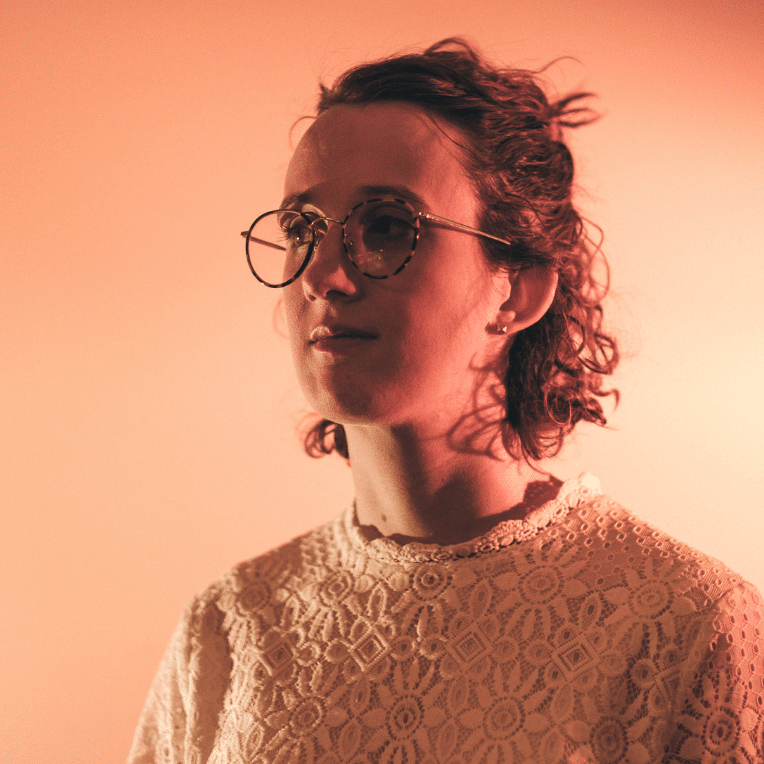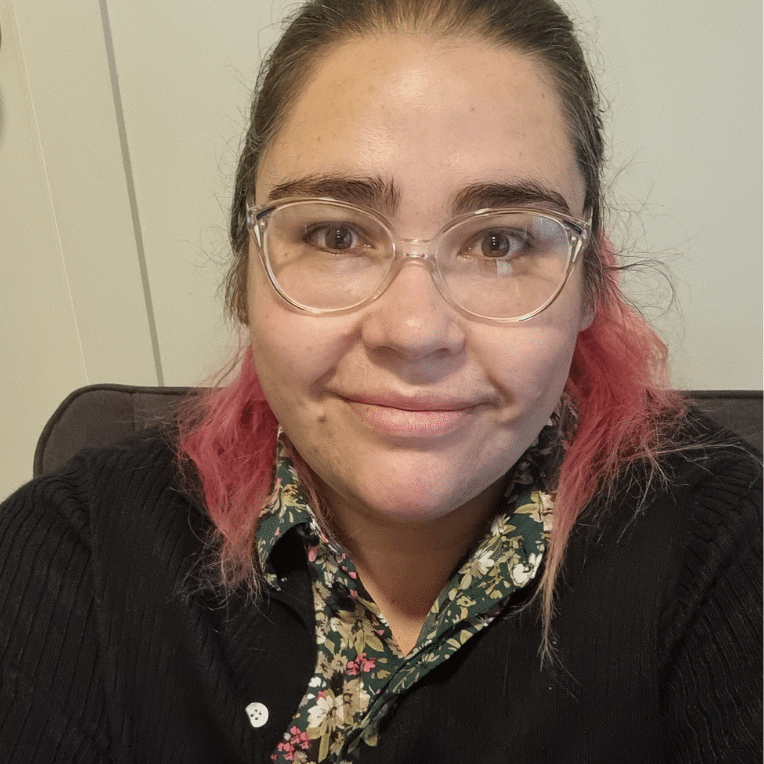Share this episode on
Our guest is Jessie Sadler, the director and founder of Christina Stephens, an inclusive clothing brand that can also be NDIS funded, which is pretty amazing.
In this episode we’ll hear how Jessie came up with the idea for Christina Stephens out of pure necessity and spotted a big gap in the disability market and how women with disabilities have embraced this amazing brand.
Produced by: Black Me Out Productions
Additional reading
View transcript
Grow Bold and Entrepreneurship
Pete and Tristram: Welcome to the Grow Bold with Disability podcast brought to you by Feros Care, a podcast dedicated to smashing stereotypes and talking about the things people with disability care about most. To help us live bolder, healthier, better connected lives. I’m journalist Pete Timbs and I’m Tristram Peters. I work for Disability Service Directory, Clickability, and am a wheelchair user living with spinal muscular atrophy.
Pete: Today’s episode of Grow Bold with Disability is Growing Bold and Entrepreneurship, and our guest is Jessie Sadler, the director and founder of Christina Stephens, an inclusive clothing brand that can also be NDIS funded, which is pretty amazing.
Pete: In this episode we’ll hear how Jessie came up with the idea for Christina Stephens out of pure necessity and spotted a big gap in the disability market and how women with disabilities have embraced this amazing brand. Jessie, welcome to Grow Bold with Disability.
Jessie: Thank you guys. Thank you for having me.
Tristram: So, Jessie, before we talk about your amazing brand, Christina Stephens, I’d love a little bit of background on you. I mean, you have a bachelor business, a master’s degree in international trade law and an MBA. Where does this love of business come from?
Jessie: Ah, so that’s a good question. Um, I guess it is being brought up in a family that was business oriented and had their own businesses, so I was always in that kind of environment and have always been involved in business one way or another. More recently, when I completed the MBA, I think business studies has evolved beyond just a financial bottom line. And now people are looking at social and environmental bottom lines as part of business activity. And that’s where probably my strongest interest is.
Pete: Well, you mentioned family business orientated. Before you got into clothing what other industries have you been involved in?
Jessie: Mainly from the energy sector, renewable energies and, most recently, oil and gas in the commercial space. So, it was quite a leap into fashion from that area.
Pete: Just a little bit different that one.
Jessie: It is yes, but I like to keep things interesting.
Pete: It wasn’t scary going from that energy sector and so forth into something that you weren’t very familiar with?
Jessie: So, I have had a lot of help in terms of bought in talent and done a few short training courses. But I guess I had a bit of time to ease my way into fashion. I gave up the oil and gas industry when I went on maternity leave with my second child, and that’s when I kind of had a bit more time to focus on what I wanted to do. And to bring myself up to speed where I needed to operate in this sector.
Tristram: And so, talking about that leap into fashion tell us about Christina Stephens. How did that all come about?
Jessie: Yeah, so it’s morphed into a brand and with products that was very different from where I started. I began looking at post-surgical clothing in the early days and, um, the more I worked on different designs and looked at what was out in the market it has evolved into something for women with movement and mobility restrictions. My mom had a fall about five years ago that really, I guess, started the concept because she’s a very trendy lady, very health conscious lady. But when she damaged her elbows, it was very limited – the options that she had out in the market and that was really annoying for her.
Pete: Now this podcast is about entrepreneurship. So, you’ve obviously at that time when your mom had hurt herself, you saw a little gap in the market. How does someone then turn that into a profitable business?
Jessie: So, we’re still working very hard to do that. We’ve been operating since the end of March this year. So, from concept to launching 77a business it’s a lot of desktop research to start with and a lot of design work and making sure that you’re working with the market you’re going to sell to. So, I was very fortunate to work with design focus groups. So, the women who I intended to sell to who were post stroke patients or were suffering from different types of arthritis – it was an iterative process in the design of these clothes to get their feedback and input. So, I think that was the most important thing, and we’ve moved on to have more formal design groups to get this next collection up and running. I hope that answers your question. It sounded like waffle.
Pete: No, no, with people starting out in a small business it’s always the first step is normally the hardest of what do I do? But obviously, with the Internet, as you say, you get down on the desktop and you just research, research, research is pretty much the background, isn’t it?
Jessie: Yeah, initially, just to get your concepts cemented in your own mind and to make sure that there is a market and there’s not a lot of competition for what you’re looking at doing. But then talking to people and as many people as you can, I can’t reinforce enough how important that is to get real life feedback once you are over the desk top research phase.
Tristram: Sure, for sure. And I know that, like in my own life, I find as a powerchair user, so difficult to buy like suits and different clothes to fit. It’s an absolute nightmare. What are some of the issues that you’re finding with clothing for ladies living with disability, what were the frustrations that they were experiencing?
Jessie: So the first one is that there is such a wide variation in physical disabilities means that there’s little choice out in the market for people, I guess, with cerebral palsy who might be in a wheelchair and also using up a stick to move around compared to someone who’s in a wheelchair full time. So they have very different needs. So, trying to find a design that can be scaled up to suit those two different customers. One of the other really interesting things was I made the assumption that an online store would be the best option, because people who are less mobile would find it harder to get out into bricks and mortar stores. And so that assumptions not entirely correct, because of where adaptive and inclusive clothing is in its growth around the world there is still a big need for women to touch and feel and check that there’s no zips until they find trust in the brand. So that’s something that we’ve had to address, and we’re looking at trying to get the label into bricks and mortar as well as online. But the online bit also is important because some of the ladies I’ve been speaking to said that even if they buy from bricks and water, they’ll never try the clothing on because the change rooms don’t suit them. They feel pressured about the amount of time they spend in change rooms. The retail assistants aren’t trained up to help them, so there needs to be a really good return policy as well. So, it’s been quite fascinating all the different needs for this particular product.
Pete: Yeah, it’s interesting you mentioned growth around the world in this industry. How is the growth around the world? Is there a lot of it happening? Are you finding there’s a really, really small market and you’ve really tapped into something here?
Jessie: In Australia we have hit jackpot because there’s not a lot happening at all. There is a much faster growing movement in the US. I think we’re about 10 years behind them. Um, and in Europe there is definitely a movement. And it’s quite a collegic community to understand which markets are doing what and how progressive they are. There are very large, um, figures, dollar figures being thrown out there about how big the adaptive clothing industry is. A lot of people in the industry are still trying to understand where that figure came from. So, it’s definitely on a growth trajectory. We in Australia can get fully funded for our clothing by NDIS, which is really fortunate. In the UK they get their VAT tax relief. So, there’s some support there for clothing. In the U.S. there is nothing. So, there’s different challenges and opportunities in each market as well.
Pete: Jesse, you did mention there that we are 10 years behind America. Where does that come from? Why do you think that is?
Jessie: Look, I’m really not sure I don’t know how to answer that. I think we are, in Australia, where the plus size clothing industry was 15 years ago and America was all over that before we were all over that, or more accepting of that. So perhaps because they have a larger population that they were able to sell into that market more readily than us in Australia before the international kind of “what is the word I am looking for?”
international sales and transactions were so much easier.
Tristram: And given obviously that we are so far behind the states I imagine these products are desperately needed and also loved from Australian customers. What’s the response been from your customers
Jessie: Yeah, it really delightful, actually. So we have a lot of support from the women we are working with. I have a very strong sustainability mandate in our manufacturing and design of the fabrics we use, so that’s had a lot of support and is a bit of a point of differentiation as well. Um, and the quality of the product, I think has been very well received. Sorry I will go back to to your question about why the States are so far ahead. They are probably not that far ahead in modern product. So, you know, a 35-year-old disabled woman was probably looking at aged care type clothing in the U. S. market in terms of availability. So, we haven’t really modernized fashion for people with disabilities collectively until more recently.
Pete: And is that being part of the drive? Because, as you say, it tended to be kind of bland, are very simple and basic materials and tends to be uncomfortable not your softer sort of materials. Has that been part of the drive for you to make it sort of “trendy?”
Jessie: Yeah. So, like, women with disabilities are like women without disabilities. They just want to look good and feel confident and value their clothing. And just saying that part of the market has been overlooked. Or there’s an assumption that people with disabilities can’t afford a quality product or that they’re happy to wear aged care, adaptive type clothing. When I speak to counterparts around the world, that’s a pretty consistent theme.
Tristram: I think it’s a great normalizing down. We really need to look good to Pete. We want to dress up.
Pete: Tris you always. You always do.
Tristram: I try, sometimes I try.
Pete: Jessie he is in his pajamas right now, so we’ll forget that.
Jessie: Oh, aren’t we all. We’re on a podcast on our phone.
Pete: Now actually, let me jump in here because this one intrigued me. When I started doing my research about Christina Stephens. Jesse, when I was looking to have a chat to you, I was looking for a Christina Stephens. I thought that was actually a person, but my research tells me it’s not. Where did the name come from?
Jessie: Yes, So I love this question because I’m constantly being called Christina. When I when I was doing my research, I was finding the labels that were out there I found were a bit condescending. And so, the names reminded me, if I was the customer, that I was wearing special clothing or I was wearing hospital clothing or it was like, um, I don’t want to use any of the competitor names. But yeah, I wanted to create a label that sounded like a designer label and as you would be aware out in the market there’s a lot TWO NAME designer labels. They sound groovy. Christine is my mother’s name, and Stephen is my dad’s name. And so, I put them together. So, it was a little bit more personal to me.
Pete: Very nice. Although Jessie Sadler is a nice name and would have sounded cool.
Jessie: I don’t think it sounds as cool as Christina Stephens.
Pete: Fair enough.
Tristram: And as we’ve touched on Christina Stephens is now NDIS funded, which is amazing. How does this happen? How do you actually achieve that status?
Jessie: So, it’s not a status. We are not a registered service provider with the NDIS. P eople who are on core supports budget and have an allocation a specific allocation can use their funding to purchase our clothing. So, you need to be within that specific budget type. And as a provider of clothing if it was extremely unclear or ambiguous, how our product was going to help a customer with NDIS funding, we would have to get a letter written by Physio or an OT to support that our product helps. Because our product is so obvious, we’ve had an easy run and customers can either request a pre purchase invoice and get approval from their plan manager, or they could just purchase it and get reimbursed. So, we’ve been very fortunate with that.
Pete: That’s great. Now you’ve mentioned sustainability a fair bit. Why is that so important to you? And what are you guys doing to achieve it?
Jessie: Yeah, So I guess, um well, to answer that is that the fashion industry, the fast fashion industry causes so much damage with landfill and dying and manufacturing, we didn’t really want to add to the problem. So, we manufacture in Australia, that may change down the road. But my reasoning to do that was that we know what our labellers are like. We know what our environmental laws like and so I was comfortable in doing that here rather than a manufacturer offshore that I wasn’t as familiar with to stop the process. With our fabrics we use all organic cotton in our range. We use all eco tech certified Australian Marino, which means that there’s no harmful chemicals in the manufacturing process. And with our bamboo I went over to China to specifically investigate the factories myself and to validate their certifications that they were environmentally friendly produced. And so that’s really important to me. We’re getting great feedback from our customers. We may use remnant fabrics down the track, which is, for example, non-organic cotton but it’s a polyester that’s been diverted from landfill and reused again in a new manufacturing process. So yeah, it is a core principle of ours.
Tristram: Fantastic. I love Marino. I think it’s amazing, but what can we do as consumers to help with this sustainability? How can we support this?
Jessie: I just think better educating yourselves. So, understanding the damage that fast fashion causes is a great start. Understanding the brands that you’re buying, and you know it’s not that hard to do a bit of digging around to see where they’re manufacturing. And you know how many collections they’re turning over in a year is a good indication if something’s fast fashion or not. But also, just consuming less like buying better. Buying pieces that can be dressed up or down is how we design so that you don’t need a different top to wear to a job interview compared to a Saturday lunch type thing. So just redefining your own wardrobe and how you how you wear it.
Pete: There’s also a little bit to be said about the old needle and thread as well. Isn’t there? Like, the other day I had a tear in my jeans, I went, you know what I’m going to fix those myself instead of throwing them out and getting a new pair.
Jessie: Good man, well done.
Pete: I didn’t know you had that skill Pete. That’s a skill.
Tristram: Oh, yes, I’m very, very handy with a needle and thread. Just ask my kids they love it.
Jessie: Well done. That’s it. That’s it. So, mending rather than throwing out as well. And I guess it’s a problem now, but the opportunity that we’ve had is that fast fashion produces cheaper clothing, which means they’re more disposable. So if we buy better, we spend a bit more, we are less likely to be so disposable about our clothes, and I just think that that’s an education that we need to teach our kids and consumers out there at moment.
Pete:100%.
Tristram: And so, I’d love to shift gears just a little bit. I mean, we’ve spoken about your experience in the business world for someone who has a business idea, and they’d like to pursue it themselves what advice do you have to them? What advice would you pass on?
Jessie: Just get started. Don’t think about it for too long, because if you go to uni and degrees or training, they will teach you to do these beautiful marketing and business plans and getting them all right, and that’s correct. But I think if you spend too much time on the academic side of starting a business rather than just getting your hands dirty and talking to people that wastes a lot of time and you might miss an opportunity. But also, I guess I just kept going back to talk to people. You don’t have to always talk to the right people. But networking is a big thing to make contacts, to find suppliers. A nd keep testing the idea. Come back, redefine it, get out there and test it again. Um, and probably do that for a few months and then just get stuck into it.
Pete: Jessie, a lot of people have the fear with this side of stuff as well is the fact that have got enough money behind them to get it off the ground. Would say the people that they need a lot of money to get something off the ground like this or is it just a lot of blood and sweat, if you know what I mean.
Jessie: Um, well, that’s how long is the pace of string. It depends what you’re doing. But, um, I would say in my experience is to do some research to put the budget together for what you think you need, go out and get quotes and get proper hard figures and then double it.
Pete: Okay,
Jessie: Because the amount of mistakes and you are going to make mistakes because you’re starting a new business. The amount of mistakes that you make is costly, and I’m not saying be irrational about how you spend your money, but you want to keep moving and making decisions rather than over analyzing every single move. Um, so I would say always over budget for starting a business. But there are a lot of great grants out there, particularly now in COVID period. The Queensland government have fabulous grants. There’s Lady Start Up through Mia Freedman for mentoring support. The federal government Oz Industry has a range of start-up stuff, so keep looking at that as a funding source matched with private funding as well.
Pete; Great advice. I love it. That’s fantastic advice.
Tristram: So, Jessie as you know, our podcast is called Grow Bold with Disability and we always like to ask our guests “What does growing bold mean to you?”
Jessie: Um, growing bold means self confidence, I guess. Um or not I guess, that’s what it means to me. So, backing yourself, not second guessing all the decisions you’re making. And again, not being afraid to try something new. I think that’s what growing bold is to me.
Tristram: Beautiful.
Pete: Fantastic. Jesse. Thank you so much for joining us today here on Grow Bold with disability brought to you by Feros Care. And listeners can find out more about Christina Stephens clothing and, of course, a little bit more about Jessie in the links provided in today’s episode show notes.
Pete: Jessie Sadler, thank you so much for joining us today. It’s been fantastic.
Jessie: Yeah, it’s been fun. Lovely. Thank you, guys.
Pete: Thank you for listening. And if you have enjoyed today’s episode that make sure you subscribe to the podcast “Grow Bold with Disability”
and if you like what you heard, then please take a few moments to pop over to iTunes and give our podcast a quick rating so we can continue these conversations and encourage people to grow bold.
Pete: This podcast is brought to you by Feros Care, an NDIS partner delivering local area coordination services in Queensland, South Australia, and the Australia Capital Territory. Feros Care is a people care organization committed to helping people leave bolder lives. We call it growing bold and for over 25 years Feros has been making it real for both older Australians and those living with disability. To find out more head to Feroscare.com.au
View podcast disclaimer
The content and views discussed in this podcast series are those of the individuals involved. They are not necessarily condoned by, or, are the views of Feros Care or its employees.
Our Guest






